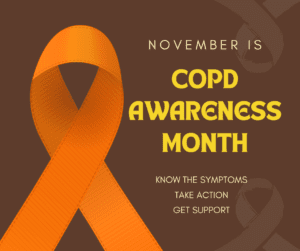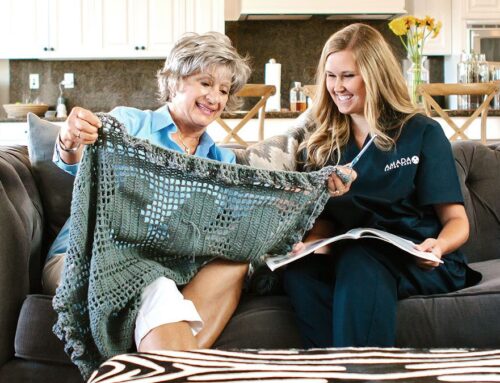Chronic Obstructive Pulmonary Disease (COPD) is a lung ailment characterized by obstructed airways and primarily manifests as chronic bronchitis and emphysema. The former causes damage to the bronchial tubes while the latter wreaks havoc on the tiny air sacs, known as alveoli, in the lungs.
Basics About Chronic Obstructive Pulmonary Disease
 COPD causes shortness of breath, intense coughing, and difficulty clearing mucus from the lungs. It’s a progressive disease, meaning that it worsens over time. About 12.5 million Americans live with COPD and the disease is fairly common in seniors, especially those who are smokers or former smokers. It’s estimated that nearly 18% of seniors aged 65 and older have COPD.
COPD causes shortness of breath, intense coughing, and difficulty clearing mucus from the lungs. It’s a progressive disease, meaning that it worsens over time. About 12.5 million Americans live with COPD and the disease is fairly common in seniors, especially those who are smokers or former smokers. It’s estimated that nearly 18% of seniors aged 65 and older have COPD.
Notably, COPD is the third leading cause of mortality in the U.S., yet despite being a widespread disease it is an often misunderstood lung condition. Differing from other lung diseases, COPD predominantly affects older adults. As a progressive disease, it evolves over a span of several years. Possessing certain risk factors for an extended period (e.g., being a lifetime smoker or occupational exposure to chemical fumes) increases the likelihood of older adults developing COPD.
COPD affects millions worldwide, and its prevalence increases with age, making our seniors more vulnerable to the condition. This topic is of great importance for our aging senior population and brings forth the question: are we closer to a cure for COPD?
Understanding COPD: Onset and Age of Patients
Generally, COPD is prevalent amongst older adults and middle-aged individuals; its occurrence in younger adults is relatively uncommon. At a young age, the lungs are typically healthy, and it takes a significant timeframe for COPD to manifest.
The onset of COPD symptoms usually starts when individuals are at least 40 years old. While it’s not impossible for young adults to develop COPD, such cases are rare.
Risk Factors for Chronic Obstructive Pulmonary Disease
Specific genetic conditions, such as alpha-1 antitrypsin deficiency, may predispose younger individuals to COPD. If COPD symptoms appear at a very young age, typically below 40, doctors may conduct screenings for such conditions. Other risk factors include:
may conduct screenings for such conditions. Other risk factors include:
- Smoking is the number one risk factor for COPD.
- Exposure to chemicals or fumes in the workplace or to secondhand smoke.
- A history with asthma or childhood respiratory infections.
- Exposure to coal or wood-burning stove.
Identifying COPD Symptoms
The progression of the disease can differ slightly between individuals; hence, paying attention to probable COPD symptoms could be more critical than concentrating solely on the age factor.
If you’re experiencing any of the following COPD symptoms, it’s important to consult with your doctor:
- Difficulty in breathing
- Breathlessness during simple activities
- Inability to execute basic tasks due to breathlessness
- Regular coughing
- Coughing up mucus, particularly in the mornings
- Wheezing
- Chest pain when attempting to breathe
Are We Closer to a Cure for COPD?
Medical research has made significant strides in understanding and treating COPD. Current treatments can manage symptoms effectively, slow the progress of the disease, and enhance overall quality of life. But in terms of a potentially transformative or curative treatment – unfortunately, the medical community is still searching.
Despite the lack of a definitive cure for COPD, hope is far from lost. Medical researchers are actively working on innovative therapies. For instance, lung volume reduction surgery, while not a cure, has shown promising results in aiding those suffering from severe cases.
Pharmaceutical advancements have led to improved inhalers and medications that reduce inflammation and expand the airways, leading to symptom relief. Genetic therapies targeting the root cause of some COPD types, smoking cessation programs, and pulmonary rehabilitation are also significant advances in managing this chronic disease.
Tips on Managing Symptoms of COPD, a Chronic Lung Disease
While we ardently hope for a cure, proactively managing symptoms is crucial to lead a healthy, fulfilling life with COPD. Here are a few tips:
- Stay Active: Regular physical activity can strengthen your respiratory muscles, improve your endurance, and help you breathe easier.
- Eat Healthy: A balanced diet rich in fruits, vegetables, and lean proteins can enhance your immune system and energy levels.
- Quit Smoking: This is the single most effective way to stop the disease from worsening. Seek help if you’re struggling with this habit.
- Get Regular Check-ups: Please don’t skip your scheduled appointments. Regular check-ups can help doctors identify red flags and adjust treatments accordingly.
- Join a Support Group: Connect with others who are living with COPD through a group like Better Breathers Club offered by the American Lung Association. Sharing experiences, fears, and coping strategies can be therapeutic and inspiring.
The Fight to Cure COPD Continues, As Does Disease Education
The progress that researchers and the medical community have made to get closer to a cure for and improve treatment of COPD is encouraging. In the meantime, we can arm ourselves with knowledge and take proactive steps to manage COPD symptoms effectively. At Amada Senior Care, our caregivers have the training and knowledge to help seniors diagnosed with COPD manage their symptoms with nonmedical in-home support that can improve their quality of life.
COPD seniors should not feel alone on this journey. Continue to talk to your healthcare provider about possible treatments that help relieve COPD symptoms you are experiencing. If you want to talk to a senior care advisor about getting help to manage your COPD symptoms, do not hesitate to reach out to Amada by clicking here to find an office near you.



